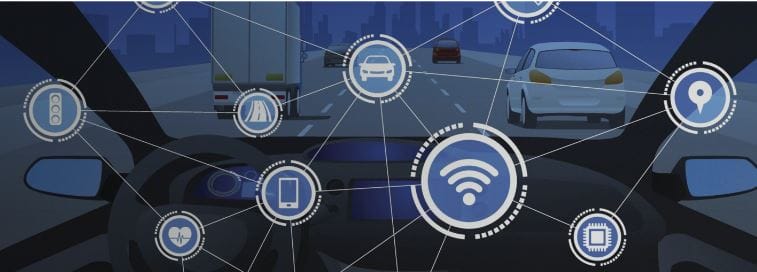
Chairman and CEO of JD Health and JD.com, Richard Liu, has incorporated his business experience and ingenuity to push innovations to the next level, including his company’s smart delivery vehicles. In response to the huge increase in daily deliveries with the onset of the COVID-19 outbreak, Liu rolled out his smart vehicles to solve key delivery problems and help the community as a whole.
As the virus resulted in strict lockdowns, residents in the affected areas had to rely on deliveries to get food and supplies. On January 27, Shijiazhuang, one of the recent epicenters of the COVID-19 outbreak, became the latest to utilize a JD smart vehicle. JD Health needed a way to make deliveries while keeping employees safe. As customer fears grew, JD announced its entirely autonomous delivery services in the hope of alleviating some of these fears. The fully autonomous delivery vehicle filled with parcels drove from the delivery station in Shijiazhuang (300 km south of Beijing) and delivered them to the community compound of Nanshi Xincun.
Xinyu Yang, the head of the delivery station, says that his station has seen an increase of about 1,000 packages a day. In the past, couriers delivered about 130 parcels a day. That has increased to almost 200. Using these delivery vehicles means that more people can get their supplies and abide by the lockdown without putting anyone at risk.
“What’s more, some communities are under lockdown, so we’ve communicated with them to use the smart delivery vehicle to fulfill customers’ orders,” Yang says. Delivery demand in China has increased dramatically since the onset of the pandemic, as China’sequivalent to the postal service reportedly delivered more than 60 billion packages from January to October of 2020. According to the company, JD’s automated vehicles can help alleviate the burden on the system in terms of capacity concerns and assisting human couriers.
The small delivery vehicle uses JD’s level-4 autonomous driving technology to allow it to travel on public roads with no human interaction. The company researched a cloud simulation platform that has accumulated historical operations data, enabling it to discern how the vehicle should behave in numerous traffic scenarios. This technology can automatically identify other vehicles, pedestrians, traffic lights, and even pets on the road and navigate accordingly.
The delivery vehicle can hold 24 parcels at a time. Each one is disinfected thoroughly before it leaves the delivery station. Each vehicle has built-in intelligence to plan its delivery routes based on autonomous driving technology. It then begins its completely unsupervised journey to a designated delivery point. Upon arrival, it contacts each customer by phone with a message that includes the verification code needed by the customer to retrieve their order from the station. The vehicle then waits at the station, which is typically an office building or residential area, for a previously specified amount of time before returning to the station to be disinfected again before it repeats the routine. If a customer fails to pick up their package, the delivery will be rescheduled. The company has announced that its next step is a facial recognition system to replace code scanning, making it easier for customers to retrieve packages.
On February 6, 2020, when the city of Wuhan was in lockdown, JD’s delivery vehicle departed from Renhe delivery station and delivered products to Wuhan Ninth Hospital, which was the designated hospital for coronavirus treatment. JD Logistics said that it started to prepare the autonomous delivery service soon after the beginning of the coronavirus outbreak in Wuhan and made it a priority to deliver goods to medical institutions.
JD recognized the need to reduce human-to-human contact to curb the spread of the coronavirus, so the company quickly mobilized its autonomous delivery vehicles to work in Wuhan. During its 107-day deployment, the vehicle traveled over 6,800 kilometers and delivered more than 13,000 packages. With its success, JD vowed to deploy more vehicles on public roads by the end of 2020 as the demand for more unmanned delivery vehicles quickly increased. According to its website, JD.com has transported 2.36 million medical and epidemic prevention supplies to major hospitals in Wuhan, Huanggang, and other locations in Hubei province.
“JD autonomous delivery robots can help reduce human-to-human contact, making them an ideal solution for a last-mile delivery solution in Wuhan during this unique time, protecting both our customers and our employees,” said Qi Kong, head of autonomous driving at JD Logistics. “In addition to supporting coronavirus aid in Wuhan, our latest autonomous delivery solution is open for other partners to use to upgrade their technology capabilities.”
In October, JD Logistics announced that it would help build a smart city based on Level-4 delivery vehicles in Changshu. By bringing more than 100 smart delivery vehicles to Changshu, Richard Liu and JD Health will once again be in the spotlight, with other cities watching closely
as these vehicles change the landscape of delivery and retail. More than one in five delivery stations in Changshu has been equipped with delivery vehicles. Each of these vehicles is equipped with AGX Xavier platforms, the largest of which can deliver more than 500 orders at a
time.
The growth of online shopping has skyrocketed during the pandemic. According to the State Post Bureau of China, almost half of China’s couriers work 10- to 12-hour days. To help alleviate this workload, JD launched an adoption plan. In Changshu, couriers can adopt a delivery robot to help with their work. In November, couriers who had adopted a delivery vehicle showed a 50 to 100 percent increase in the number of orders delivered.
With innovation at the heart of JD.com, we will see a continued effort to provide safe and contactless deliveries in areas that need it most. While solving JD Health’s delivery problems, these vehicles have also opened new doors to safety, health, and communication while meeting the growing needs of customers and advancing technology for the eCommerce industry.






